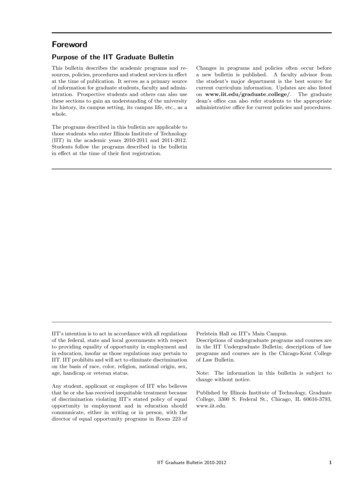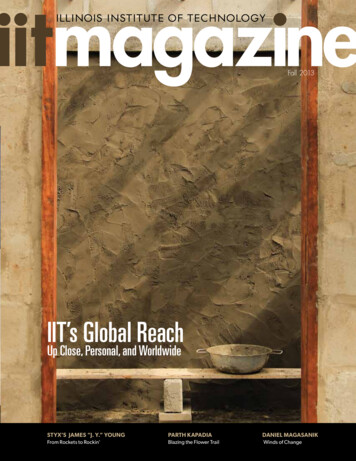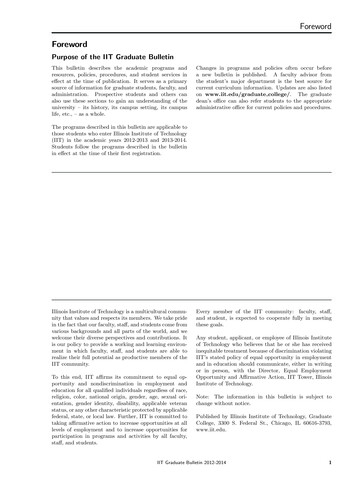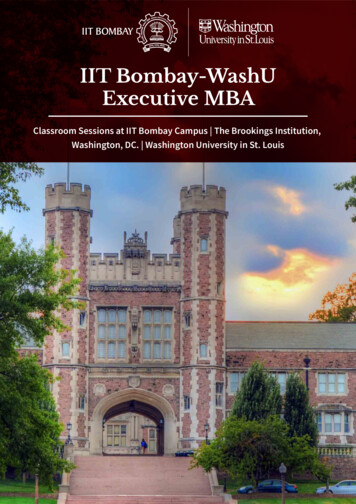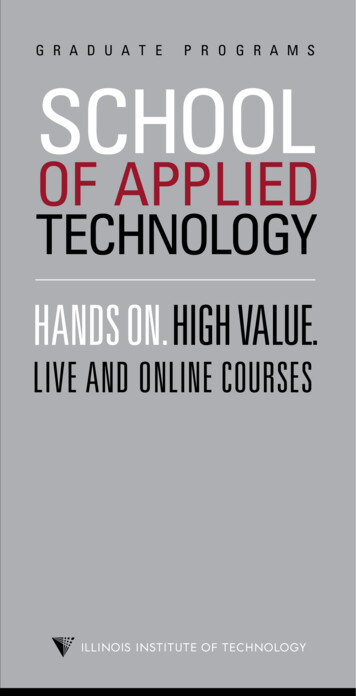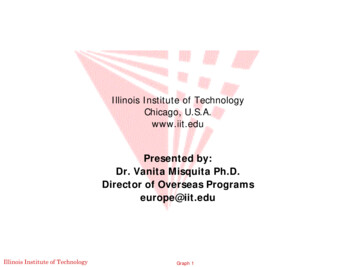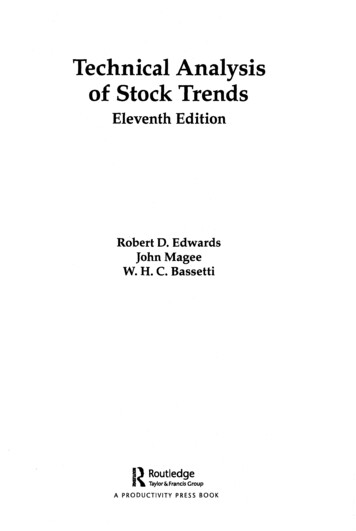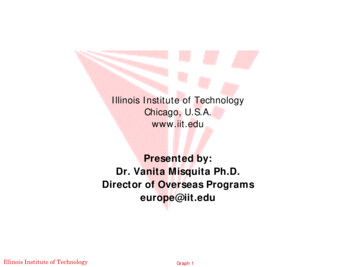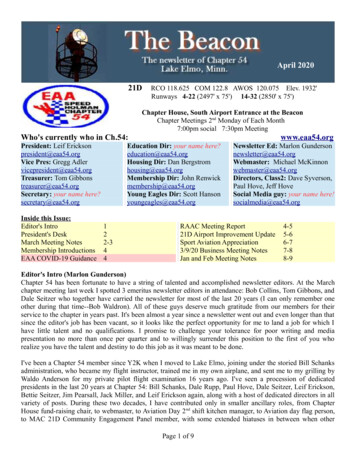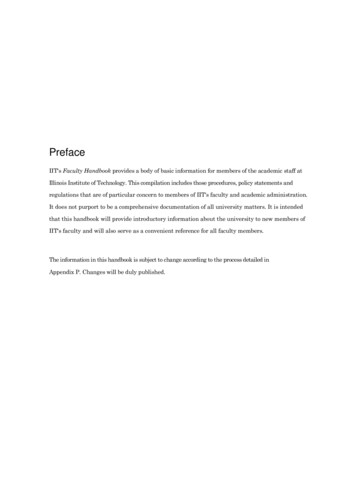
Transcription
PrefaceIIT's Faculty Handbook provides a body of basic information for members of the academic staff atIllinois Institute of Technology. This compilation includes those procedures, policy statements andregulations that are of particular concern to members of IIT's faculty and academic administration.It does not purport to be a comprehensive documentation of all university matters. It is intendedthat this handbook will provide introductory information about the university to new members ofIIT's faculty and will also serve as a convenient reference for all faculty members.The information in this handbook is subject to change according to the process detailed inAppendix P. Changes will be duly published.
I.IntroductionA. The UniversityIllinois Institute of Technology (IIT) is an independent, non-sectarian, co-educational, and urbanuniversity emphasizing education for the professions, research, and scholarship. The university offersprograms in engineering, science, architecture, law, business, psychology, and design, and is a memberof the Association of Independent Technological Universities. With its contract research arm, IITResearch Institute (IITRI), IIT is a major center of applied science and engineering research. IIT has fivecampuses in the Chicago area: the Main Campus on Chicago’s mid-South Side; the Downtown Campusin Chicago’s West Loop; the Daniel F. and Ada L. Rice Campus in west suburban Wheaton; the MoffettCampus in south suburban Bedford Park, where the National Center for Food Safety and Technology islocated; and the Institute of Design (ID) at 350 N. LaSalle St., in Chicago. In the 1950s, the university’sMain Campus was designed by master architect Ludwig Mies van der Rohe and has been designated oneof the 200 most architecturally significant sites in the United States. The opening in 2003 of a newcampus center designed by Rem Koolhaas and a dormitory by renowned architect Helmut Jahn hasbroadened and enhanced the architectural significance of the Main Campus.B. HistoryIn 1890, when advanced education was often reserved for society’s elite, Chicago minister FrankGunsaulus delivered what came to be known as the “Million Dollar Sermon.” From the pulpit of hisSouth Side church—near the site IIT now occupies—Gunsaulus said that with a million dollars he couldbuild a school where students of all backgrounds could prepare for meaningful roles in a changingsociety. Industrialist Philip Danforth Armour heard Gunsaulus’ sermon and came to share his vision. Heagreed to finance the endeavor with the stipulation that Gunsaulus become the first president of ArmourInstitute.When Armour opened in 1893 it offered professional courses in engineering, chemistry, architecture, andlibrary science. Armour Research Institute, the predecessor to IITRI, was formed in 1936 as theuniversity’s not-for-profit research arm. It applied science and technology to solve problems for industryand government.IIT was created in 1940 by the merger of Armour Institute with Lewis Institute, a West Side Chicagocollege that offered liberal arts as well as science and engineering courses. In 1949 the Institute of Designmerged with IIT, thereby bringing to the university the teachings of ID’s founder, Laszlo Moholy-Nagy,whose work altered the history of photography, film, and typography.In 1969 IIT became one of the few technology-based universities with a law school when Chicago-KentCollege of Law, founded in 1888, became part of the university. Stuart School of Business was added in1969, funded by a gift from the estate of Lewis Institute alumnus and Chicago financier Harold LeonardStuart. The Midwest College of Engineering, founded in 1967, joined the university in 1986 to form thenucleus of what is now the Rice Campus in Wheaton. A gift of buildings by CPC International in southsuburban Bedford Park in 1988 made possible the IIT Moffett Campus. The Downtown Campus, a 10story building at 565 W. Adams St. in Chicago’s West Loop, opened in January 1992, and is home to thelaw school, some programs of the business school, as well as the master’s degree program in publicadministration.I-104/2013
In early 1998 the Institute of Design moved from the Main Campus to the building then known as theSteelcase Building in Chicago’s River North section, a step designed to help ID expand its continuingand executive education programs and to bolster graduate enrollment. In 2002 a majority of the assets ofIITRI were sold to Alion Science and Technology Corporation, a for-profit company whose soleshareholder is an Employee Stock Ownership Plan formed and owned by former employees of IITRI.IITRI, consisting primarily of its Life Sciences Operation, continues as an independent not-for-profitcorporation controlled by the university.In November 1996, longtime trustees Robert A. Pritzker and Robert W. Galvin offered the university arecord-breaking 120 million challenge grant, launching the five-year IIT Challenge, a campaign thathelped to spur IIT’s revitalization and to assure its leadership in higher education for decades to come.The funds were used to provide scholarships for outstanding students, to facilitate faculty development,and to support and upgrade university facilities, including construction of the new McCormick TribuneCampus Center designed by Dutch architect and Pritzker Prize awardee Rem Koolhaas, and a newresidence hall designed by the internationally renowned Helmut Jahn.C. A Record of AccomplishmentEven more impressive than the physical growth of the university over its first century is the remarkablerecord of accomplishment by its students, faculty, and alumni. Lee DeForest, “Father of the Radio,”conducted his first long-distance broadcasts from the roof of Main Building while on the Armour faculty.Jazz great Benny Goodman and journalist Dorothy Thompson distinguished themselves after studying atLewis. S. I. Hayakawa, world-renowned expert in semantics, taught at IIT and wrote the best-sellingbook, Language in Action, while on the faculty. Nobel Laureate Herbert Simon wrote his groundbreakingbook, Administrative Behavior, while professor and department chair of political science at IITfrom1942–1947. The only known recording from the 1940s of survivors displaced by Germany in WorldWar II was obtained in 1946 via wireless recording by psychology professor David P. Boder. ChicagoKent graduate Richard Ogilvie capped a distinguished career with election to the office of governor ofIllinois. IIT architects and engineers have literally shaped the Chicago skyline, helping to design andconstruct such landmark buildings as the Sears Tower, the John Hancock Building, McCormick Place,Lake Point Tower, Marina City, River City, and Water Tower Place.More recently, IIT alumnus Martin Cooper led the team that pioneered cellular telephone technology atMotorola, Inc. Students from the Institute of Design have won the Osaka Biennial Design Competition’sprestigious Grand Prize twice, besting international student, faculty, and professional teams of designers.In 1990 President George H. W. Bush awarded research professor and alumnus Marvin Camras theNational Medal of Technology, the highest honor bestowed by the President for technologicalachievement. Camras held more than 500 patents and was inducted into the Inventors Hall of Fame as the“Father of Magnetic Recording.” The Camras scholarships launched by IIT in 1996 to attract the best andbrightest high school students to careers in engineering are named in his honor.I-204/2013
II. Mission“To provide distinctive and relevant education in an environment of scientific, technological, andprofessional knowledge creation and innovation.”The schools envisioned more than 100 years ago when the predecessors of IIT were created today havebecome a university offering a bold intellectual agenda for a changing world. Educating the women and menwho will become tomorrow’s leaders is fundamental to IIT’s mission.While IIT’s core mission entails education and research, the university also recognizes its importance to thelife of the historic Bronzeville neighborhood in Chicago where its Main Campus is located. As one of themajor anchor institutions in this neighborhood, IIT plays a key role in the area’s economic renewal.04/2013II-1
III. Academic GovernanceA. The Board of TrusteesThe Board of Trustees is charged with final responsibility for the operations of IIT. The Board assessesthe performance of the university and its president to assure that IIT serves the public interest in itschosen range of activities. The Board assures the prudent management of IIT’s finances, leads inproviding the resources needed to carry out the university’s objectives, protects the university fromundue external pressures, and functions as a bridge between IIT and the outside community. The Board iscomposed of prominent business, industrial, community, and professional leaders who place their time,talents, and resources at the disposal of the university. The names of the members of the Board ofTrustees are listed in major university publications.B. Academic AdministrationResponsibility for carrying out resolutions of the Board of Trustees and for implementation of its policiesis placed upon the President and those to whom the President may delegate responsibility. The Provostadministers the academic-related support services through the academic unit heads and otheradministrative officers. Objectives of the academic administration include creating and supporting anoutstanding community of faculty and students, providing a working environment that facilitatesscholarly achievement, and planning the long-range development necessary for IIT’s continuingprogress.C. Academic UnitsAn academic unit is a degree-granting group of faculty having among its members one or more tenuredfaculty whose primary appointment is in that unit. The current academic units are Chicago-Kent Collegeof Law; the Stuart School of Business; the College of Architecture; the Graduate School of Design; theSchool of Applied Technology; and the Departments of Applied Mathematics, Biological and ChemicalSciences, Physics, Biomedical Engineering, Chemical & Biological Engineering, Civil, Architectural &Environmental Engineering, Computer Science, Electrical & Computer Engineering, Humanities,Mathematics & Science Education, Mechanical Materials & Aerospace Engineering, Psychology andSocial Sciences.D. The FacultyThe IIT faculty consists of all individuals who hold regular full-time faculty appointments at theuniversity, including the President and the Provost. Those who hold adjunct professorial rank and teachat least three 50-minute periods per week per semester, or the equivalent, also are considered members ofthe faculty. Senior research associates and research associates hold academic appointments but are notmembers of the faculty. The undergraduate and graduate bulletins, and the university’s web site, list themembers of IIT’s faculty. Specific voting privileges of various categories of faculty are discussed inAppendices A, B, and Q of this Handbook.Active emeriti faculty members and tenured and tenure-track faculty members hold voting rights asmembers of the faculty and are classified as “regular voting members”. Active emeriti faculty membersare those emeriti faculty members who continue to participate in university affairs. On or beforeSeptember 30 of each year, each academic unit will provide to the Office of the Provost a list of thoseemeriti faculty members who meet this definition and should be considered as active emeriti facultymembers for that academic year. In order to provide suitable representation at faculty meetings toIII-104/2013
colleges, schools, departments, centers and institutes, the voting faculty may extend membership andvoting rights to other persons as provided in the constitution and by-laws of the IIT faculty. (AppendicesA and B.)Meetings of the university faculty are held at least twice each year, at which time the University FacultyCouncil (sometimes referred to herein as the “UFC”) reports its deliberations, decisions, and actions. Atits meetings the Faculty may act on matters of particular significance brought before it by the UniversityFaculty Council, the President or the Provost. The President serves as president of the Faculty. TheSecretary of the University Faculty Council serves as Secretary of the Faculty. Members of the Facultyare organized into academic units, as described in the preceding section.E. Constitution and By-Laws of the Faculty of Illinois Institute of TechnologyThe IIT Faculty Constitution and By-Laws (see Appendices A and B, respectively, for the full text ofeach document) describe the composition, structure, and functions of the University Faculty Council andthe Faculty Senate. These documents set forth the procedures for selection of officers of the Faculty,election of UFC members, and conduct of Faculty meetings. The composition and functions of facultystanding committees are also discussed. These documents are subject to the review and approval of theBoard of Trustees.III-204/2013
IV. Conditions of Academic AppointmentA. Locus of AuthorityIIT is a private university. The ultimate authority to determine policy and conditions of academicappointment resides with the Board of Trustees and is vested by the Board in the President and theProvost. Working procedures have been developed for obtaining the advice and recommendations of thefaculty and members of the academic administration concerning decisions involving policy changes andthe selection, retention, promotion, advancement to tenured status, and termination of faculty members.These procedures and their implementation remain subject, however, to the approval of the Board ofTrustees and those named to administer its directives.B. Faculty Appointments and Faculty RanksAll full-time faculty positions fit into one of the following four categories. Some of the ranks requirefurther definition by the academic units using them. However, the following standards apply to all facultyin those categories holding these ranks. Procedures for review and renewal are set out in Appendix C forpersons holding Category I ranks and in Appendix Q for persons holding Category II and III ranks.Appendix Q also contains information regarding limits on the number of appointments in thosecategories and on voting rights. Other ranks may be added to Categories II and III upon approval of thePresident, the UFC, and the IIT Faculty.1.Category ITenured and tenure-track faculty constitute Category I faculty. These are the traditional ranks, andindividuals holding these ranks form the “core” of the faculty. Their roles in teaching, research, andservice are well understood. Active professors emeriti are also Category I faculty.a.ProfessorAppointment to the rank of professor carries permanent tenure. Such appointment shall becontinued until (1) retirement, (2) resignation, (3) dismissal with cause as set forth in AppendixJ, or (4) declaration by the Board of Trustees that the university is suffering from extraordinaryfinancial exigency. In cases where the first appointment at IIT is in this rank, the award ofcontinuous tenure shall be subject to consideration under the university’s procedures forpromotion and granting of tenure.b.Associate ProfessorPromotion to the rank of associate professor from the rank of assistant professor carriescontinuous tenure under the same provisions and limitations as apply to professor. In caseswhere the first appointment at IIT is in this rank and is without tenure, such appointment shallbe for a four-year term and shall be subject to notification of termination or award of tenure atthe end of three years. An associate professor in his or her third year may petition the academicunit head to defer consideration to the fourth year. However, if the request for deferral is grantedand tenure subsequently is not awarded, the fourth year constitutes the terminal year and therecan be no extension of the terminal contract. In cases where the first appointment at IIT is in thisrank with tenure, the award of tenure shall be subject to consideration at the time of hire underthe university’s procedures for promotion and granting of tenure. Typically, time spent on leaveof absence by an untenured faculty member is not counted as part of a probationary appointmentat IIT. However, agreement on whether or not a leave of absence is to be considered part of aIV-104/2013
probationary term must be reached before approval of the leave of absence is granted, except asotherwise provided in the Faculty Family Policy, included in the Supplement to the Handbook.Under that Policy, leaves of absence for birth or adoption of a child do not require priorapproval and time spent on such leaves are not counted as part of the probationary appointment.c.Assistant ProfessorTwo options are available for the appointment or reappointment of an assistant professor: (1) aninitial probationary period of four years, with a possible renewal for a term of three years; or (2)an initial probationary period of three years, with a possible renewal for a term of fouradditional years. Each academic unit shall publish its policy as to which option it follows. Thepolicy must be uniform for each assistant professor appointee within that academic unit. Anassistant professor must be considered for tenure no later than his or her sixth year in this rank atIIT. An assistant professor in his or her sixth year may petition the academic unit head to deferconsideration to the seventh year. However, if the request for deferral is granted, and tenure isnot awarded, the seventh year constitutes the terminal year and there can be no extension of theterminal contract. An assistant professor’s appointment shall be terminated if the facultymember is not promoted prior to, or at the end of, the second appointment. Notice of terminationof appointment at the end of the first or second terms shall be given at the end of the yearpreceding the terminal year of the appointment. Typically, time spent on leave of absence by anuntenured faculty member is not counted as part of a probationary appointment at IIT. However,agreement on whether or not a leave of absence is to be considered part of a probationary termmust be reached before approval of the leave of absence is granted, except as otherwiseprovided in the Faculty Family Policy, included in the Supplement to the Handbook. Under thatPolicy, leaves of absence for birth or adoption of a child do not require prior approval and timespent on such leaves are not counted as part of the probationary appointment.d. Emeritus FacultyAppointment to the rank of associate professor emeritus, professor emeritus, or distinguishedprofessor emeritus may be awarded to a retiring full-time tenured faculty member in recognitionof his or her distinguished service to the university. The appointment is made upon the jointrecommendation of the academic unit, the dean of a college (in the case of an academic unit thatis located within a college with departments) and the Provost. Notice of the appointment isgiven by letter from the President or from such other academic administrator as the Presidentmay designate. The list of emeritus faculty is published in the undergraduate and graduatebulletins and on the university’s web site. Active emeritus faculty can be principal investigatorsin research and sponsored program proposals and advise graduate student research as primaryadvisor but only with a tenured or tenure-track faculty member as co-principal investigator inthe research proposal and as co-advisor of the student.2.Category IILong-term, non-tenured faculty constitute Category II faculty. These ranks are intended for facultymembers who make a long-term commitment to the university, but who do not serve in roles thatordinarily would qualify them for tenure. Faculty members in this category will have contracts fromone year to five years in duration, with no limit on the number of renewals, except as otherwiseprovided below for assistant professors of legal writing. A renewal of a contract may be for a shorteror longer term than the term of the predecessor contract. In the case of a faculty member who is inhis or her sixth through tenth year of service with the university, and who is not going to receive aIV-204/2013
renewal of his or her contract, notice of such non-renewal shall be given to him or her by theacademic unit head at least one academic year prior to the expiration of his or her current contract. Inthe case of a faculty member with eleven or more years of service with the university and who is notgoing to receive a renewal of his or her contract, notice of such non-renewal shall be given to him orher by the academic unit head at least two academic years prior to the expiration of his or her finalcontract. If timely notice is not given to the faculty member, he or she shall receive a terminalcontract at least equal to the period of time that the notice was untimely. For example, if notice isgiven eight months late, the faculty member shall be entitled to a contract of at least eight months’duration.a.Clinical ProfessorClinical faculty members are those who bring professional expertise to the classroom, but whousually do not participate in academic research and/or scholarship. Three faculty ranks havebeen established for clinical educators: clinical assistant professor, clinical associate professor,and clinical professor. An academic unit may determine the length of a clinical facultymember’s contract, within the one- to five-year terms described above.Appointment to a clinical rank carries no implication of tenure or continuing connection withthe university beyond the contract term. The renewal of a contract is subject only to the needs ofthe academic unit and the mutual agreement of the individual and the university. Academicresponsibilities and compensation are determined by the director or dean of the college orschool in which the individual is employed, and specified in the contract between the universityand the clinical faculty member.b.Studio ProfessorAppointment to the ranks of studio professor, studio associate professor, and studio assistantprofessor are made to recognized outstanding practitioners who may continue to practice in theirfields. The renewal of a contract is subject only to the needs of the academic unit and the mutualagreement of the individual and the university. Workload and compensation are determined bythe academic unit head and specified in the contract between the university and the studioprofessor.c.Senior Lecturer and Senior InstructorAppointment to the rank of senior lecturer and senior instructor is made to an individual who iscommitted to teaching and other professional activities, but who ordinarily does not participatein academic research and/or scholarship. The renewal of a contract is subject only to the needsof the academic unit and the mutual agreement of the individual and the university. Workloadand compensation are determined by the academic unit head specified in the contract betweenthe university and the individual.d.Legal Writing ProfessorProfessors of legal writing are those who have demonstrated excellence in teaching legal writingand doctrinal law courses and who are active participants in institutional service and in theintellectual life of the law school. The term for this rank is an initial appointment of two years asan assistant professor of legal writing, based on the vote of the tenured faculty to recommendthe appointment to the dean. Such appointments may be renewed for a maximum of twoadditional years. The terms for appointments to the rank of associate professor of legal writingIV-304/2013
and professor of legal writing shall be for three and five years, respectively, and are made by thedean upon the recommendation of the appropriate law school committee.e.Industry Professor and Industry Associate ProfessorAppointment to the rank of industry professor or industry associate professor is made to anindividual with substantial experience in business or industry who will bring his or herprofessional expertise to teaching and other professional activities, not including research.Course load and compensation will be determined by the academic unit head and specified in acontract between the faculty member and the university. Renewal of the contract is subject toonly the needs of the academic unit and the mutual agreement of the individual and theuniversity.3.Category IIIFull-time, short-term faculty with little university commitment, including visiting and researchfaculty, constitute Category III faculty. Faculty members in this category receive contracts forone or two years; they may serve for no more than four years in a period of seven years.However, appointments to the ranks of distinguished research professor, research professor,research associate professor, and research assistant professor are not subject to these durationallimitations. Notice of renewal or non-renewal shall be given by the end of the last academic yearof the contract in force.a. Visiting FacultyAppointment to any of the visiting ranks is not permanent and carries no implication of tenureor continuing connection with the university. Such an appointment is made on an annual basis.Generally the period of service as a visiting member of the faculty shall not be extended beyondtwo years, although under special circumstances appointment may be continued on an annualbasis for a period not to exceed another two years. Academic responsibilities and compensationare determined by the academic unit head and specified in a contract between the university andthe individual.b.Distinguished Research ProfessorAppointment to the rank of distinguished research professor is made to a person who hasachieved preeminence in his or her field of expertise, as defined in Appendix O regarding thehonorific title of distinguished professor. This appointment may be made to a person who hasbeen affiliated with another university, a research laboratory, or an industrial organization, aswell as to an IIT professor who has retired. Such an appointment is made on an annual basis andcarries no implication of tenure or continuing connection with the university. Renewal of theappointment is subject only to the needs of the academic unit and the mutual agreement of theindividual and the university. A distinguished research professor may serve with a tenure-trackfaculty member as a co-adviser, but not as a sole adviser, for graduate students. Workload andcompensation are determined by the academic unit head and specified in a contract between theuniversity and the individual.c.Research Professor and Research Associate ProfessorAppointments to the rank of research professor and research associate professor are made torecognized outstanding professionals who may continue to practice in their fields. Such anIV-404/2013
appointment is made on an annual basis and carries no implication of tenure or continuingconnection with the university. The terms of each annual appointment are subject to the needs ofthe department and the mutual agreement of the individual and the university. A researchprofessor or a research associate professor may serve with a tenure-track faculty member as aco-adviser, but not as a sole adviser, for graduate students. Workload and compensation aredetermined by the academic unit head and specified in a contract between the university and theindividual.d.Research Assistant ProfessorAppointment to the rank of research assistant professor is made to a professional who showspromise of developing into an outstanding researcher in his or her field. Such an appointment ismade on an annual basis and carries no implication of tenure or continuing connection with theuniversity. The terms of each annual appointment are subject to the needs of the academic unitand the mutual agreement of the individual and the university. A research assistant professormay serve with a tenure-track faculty member as a co-adviser, but not as a sole adviser, forgraduate students. Workload and compensation are determined by the academic unit head andspecified in a contract between the university and the individual.e.Instructor and LecturerAppointment to the ranks of instructor and lecturer are not permanent and carry no implicationof tenure or continuing connection with the university. Such an appointment is made on anannual basis. Workload and compensation are determined by the academic unit head andspecified in a contract between the university and the individual.4.Category IVThis category includes highly distinguished faculty who may be appointed directly by the Presidentin recognition of their national reputations.University ProfessorAppointment to the rank of university professor is made by the President in the case of prestigiousmembers of the academic or other professional community. The terms of appointment are set by thePresident.In the case of an initial proposed appointment of an individual who will be affiliated with anacademic unit, the nominee’s appointment shall be subject to review by, and the consent of, therelevant Academic Unit Committee on Promotion and Tenure (AUCOPT).An affirmative recommendation by the AUCOPT shall be reviewed by the University Committee onPromotion and Tenure (UCOPT), which shall submit a recommendation to the President, whichrecommendation shall be accompanied by the documentation received from the AUCOPT.In the case of a proposed initial appointment of an individual who will not be affiliated with anacademic unit, the nominee’s appointment shall be reviewed by the UCOPT, which shall submit arecommendation to the President.IV-504/2013
Renewals of appointments may be made by the President without additional reviews by the relevantAUCOPT or by the UCOPT, unless
university's not-for-profit research arm. It applied science and technology to solve problems for industry and government. IIT was created in 1940 by the merger of Armour Institute with Lewis Institute, a West Side Chicago college that offered liberal arts as well as science and engineering courses. In 1949 the Institute of Design

